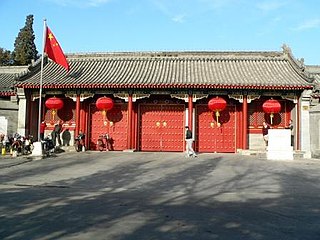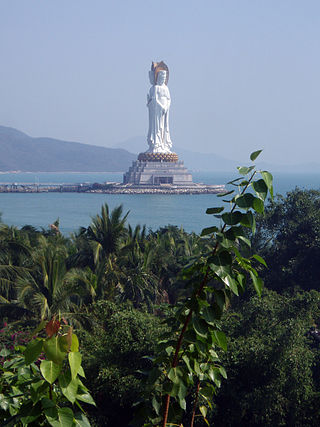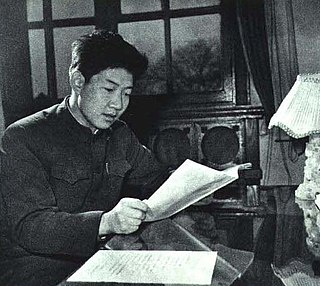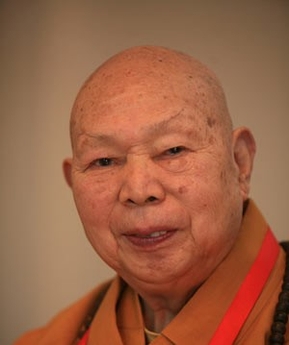
Amitābha is the principal Buddha of Pure Land Buddhism. He is also known as Amitāyus, which is understood to be his enjoyment body (Saṃbhogakāya). In Vajrayana Buddhism, Amitābha is known for his longevity, discernment, pure perception, and the purification of aggregates with deep awareness of the emptiness of all phenomena. The name Amitābha means "Infinite Light", and the name Amitāyus means "Infinite Life".

Chinese Buddhism or Han Buddhism is a Chinese form of Mahayana Buddhism which draws on the Chinese Buddhist canon as well as numerous Chinese traditions. Chinese Buddhism focuses on studying Mahayana sutras and Mahāyāna treatises and draws its main doctrines from these sources. Some of the most important scriptures in Chinese Buddhism include: Lotus Sutra, Flower Ornament Sutra, Vimalakirtī Sutra, Nirvana Sutra, and Amitābha Sutra. Chinese Buddhism is the largest institutionalized religion in mainland China. Currently, there are an estimated 185 to 250 million Chinese Buddhists in the People's Republic of China. It is also a major religion in Taiwan, Singapore, and Malaysia, as well as among the Chinese Diaspora.
A tulku is a distinctive and significant aspect of Tibetan Buddhism, embodying the concept of enlightened beings taking corporeal forms to continue the lineage of specific teachings. The term "tulku" has its origins in the Tibetan word "sprul sku", which originally referred to an emperor or ruler taking human form on Earth, signifying a divine incarnation. Over time, this term evolved within Tibetan Buddhism to denote the corporeal existence of highly accomplished Buddhist masters whose purpose is to ensure the preservation and transmission of a particular lineage.

The United Front Work Department (UFWD) is a department of the Central Committee of the Chinese Communist Party (CCP) tasked with "united front work." It gathers intelligence on, manages relations with, and attempts to gain influence over elite individuals and organizations inside and outside mainland China, including in Hong Kong, Taiwan, and in other countries.

Chökyi Gyalpo, also referred to by his secular name Gyaincain Norbu or Gyaltsen Norbu, is considered the 11th Panchen Lama by the government of the People's Republic of China (PRC). He is also the vice president of the Buddhist Association of China. Gyalpo is considered by critics to be a proxy of the Chinese government.

Lobsang Trinley Lhündrub Chökyi Gyaltsen was the tenth Panchen Lama, officially the 10th Panchen Erdeni, of the Gelug school of Tibetan Buddhism. According to Tibetan Buddhism, Panchen Lamas are living emanations of the buddha Amitabha. He was often referred to simply as Choekyi Gyaltsen.

Chinese Taoist Association, founded in April 1957, is the official government supervisory organ of Taoism in the People's Republic of China.

Buddhism is the largest religion in Mongolia practiced by 51.7% of Mongolia's population, according to the 2020 Mongolia census. Buddhism in Mongolia derives much of its recent characteristics from Tibetan Buddhism of the Gelug and Kagyu lineages, but is distinct and presents its own unique characteristics.
The united front is a political strategy of the Chinese Communist Party (CCP) involving networks of groups and key individuals that are influenced or controlled by the CCP and used to advance its interests. It has historically been a popular front that has included eight legally permitted political parties and people's organizations which have nominal representation in the National People's Congress and the Chinese People's Political Consultative Conference (CPPCC). Under CCP general secretary Xi Jinping, the united front and its targets of influence have expanded in size and scope.

The National Religious Affairs Administration (NRAA), formerly the State Administration for Religious Affairs (SARA), is an external name of the United Front Work Department of the Central Committee of the Chinese Communist Party (CCP). Formerly, it was an executive agency directly under the State Council of the People's Republic of China which oversaw religious affairs in the country. SARA was merged into the UFWD in 2018. The names of the former agency were retained by the UFWD as external names under the system called "one institution with two names".
State Religious Affairs Bureau Order No. 5, officially named Measures on the Management of the Reincarnation of Living Buddhas in Tibetan Buddhism, is an order passed during a conference of the State Administration for Religious Affairs on 13 July 2007, marked for implementation on 1 September 2007.

The Guanyin of Nanshan is a 108-metre (354 ft) statue of the bodhisattva Guanyin, sited on the south coast of China's island province Hainan near the Nanshan Temple of Sanya.

Zhao Puchu was a religious and public leader who promoted cultural progress and religious tolerance in China. Zhao was best known as president of the Buddhist Association of China and also one of the most renowned Chinese calligraphers.

Xuecheng is a Chinese Buddhist monk, a former member of the National Committee of the Chinese People's Political Consultative Conference, and a popular blogger. He was president of the Buddhist Association of China from 2015 to 2018 when he resigned after allegations that he had engaged in corruption and sexual assault surfaced. He was ordered to be punished by the National Religious Affairs Administration after they corroborated the allegations.

Longquan Monastery, also called Longquan Temple or Beijing Longquan Monastery is a Chinese Buddhist monastery located in the suburban area of Beijing, China. It was originally established in Liao dynasty and recently revived on April 11, 2005 by Ven. Master Xuecheng.

Pagbalha Geleg Namgyai is the 11th Qamdo Pagbalha Hutuktu of Tibetan Buddhism and a politician of the People's Republic of China. He is a Vice Chairman of the Chinese People's Political Consultative Conference (CPPCC), and the Honorary President of the Buddhist Association of China. He also formerly served as a Vice Chairman of the National People's Congress, Vice Chairman of the Tibet Autonomous Region, and Vice President of the Buddhist Association of China. As a Tibetan tulku, he is notable for his willingness to work in the Chinese government, except during the Cultural Revolution.

Yicheng was a Chinese Buddhist monk, Chan master and religious leader. Yicheng was best known as Venerable Master of the Buddhist Association of China.

The Zhenru Chan Temple is a Chan Buddhist temple located on the southwestern hillside of Mount Yunju in Yongxiu County, Jiangxi, China. Zhenru Chan Temple is the cradle of Caodong school in Chinese Buddhism. The temple has been burned down and rebuilt several times due to wars and fires. The present version was completed in the 1950s.

Caotang Temple is a Buddhist temple located on the north hillside of Mount Guifeng, in Huyi District of Xi'an, Shaanxi, China.

Guangren Temple, also called Guangren Lama Temple, is a Buddhist temple located in Lianhu District of Xi'an, Shaanxi, China. It is the only Tibetan Buddhist temple in Shaanxi.
















